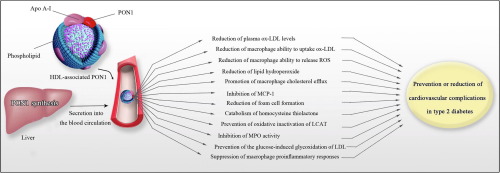当前位置:
X-MOL 学术
›
Diabetes Res. Clin. Pract.
›
论文详情
Our official English website, www.x-mol.net, welcomes your feedback! (Note: you will need to create a separate account there.)
Importance of paraoxonase 1 (PON1) as an antioxidant and antiatherogenic enzyme in the cardiovascular complications of type 2 diabetes: Genotypic and phenotypic evaluation.
Diabetes Research and Clinical Practice ( IF 5.1 ) Pub Date : 2020-02-07 , DOI: 10.1016/j.diabres.2020.108067 Yasaman Shokri 1 , Atena Variji 1 , Mani Nosrati 1 , Abbas Khonakdar-Tarsi 2 , Anvarsadat Kianmehr 3 , Zahra Kashi 4 , Adele Bahar 4 , Abouzar Bagheri 2 , Abdolkarim Mahrooz 5
Diabetes Research and Clinical Practice ( IF 5.1 ) Pub Date : 2020-02-07 , DOI: 10.1016/j.diabres.2020.108067 Yasaman Shokri 1 , Atena Variji 1 , Mani Nosrati 1 , Abbas Khonakdar-Tarsi 2 , Anvarsadat Kianmehr 3 , Zahra Kashi 4 , Adele Bahar 4 , Abouzar Bagheri 2 , Abdolkarim Mahrooz 5
Affiliation

|
Oxidant-antioxidant imbalance is involved in the etiology of different diseases, including cardiovascular diseases (CVDs), liver disorders, kidney diseases, cancers and diabetes mellitus. Antioxidant enzymes play a key role in striking an oxidant-antioxidant balance. Moreover, paraoxonase 1 (PON1) is an antioxidant enzyme that binds with high-density lipoprotein (HDL) in the circulation, and antioxidant and antiaterogenic properties of this lipoprotein are significantly associated with PON1. Research suggests PON1 contributes to the pathogenesis of certain human diseases such as type 2 diabetes (T2D). The association between PON1 and T2D appear to be reciprocal so that the disease significantly decreases PON1 levels and in turn, the genetics of PON1 may have a role the risk of susceptibility to T2D. Several factors that reduce the activity and concentration of PON1 in patients with T2D include increased glycation and loss-of-function polymorphisms. The genotypic and phenotypic evaluations of PON1 are therefore crucial for assessing the risk of cardiovascular complications in these patients, and strategies for increasing or restoring PON1 levels are useful for reducing or preventing their cardiovascular complications as their main cause of mortality. The present review aimed at discussing and emphasizing the key role of PON1 in T2D as a silent and dangerous disease.
中文翻译:

对氧磷酶1(PON1)作为抗氧化剂和抗动脉粥样硬化酶在2型糖尿病心血管并发症中的重要性:基因型和表型评估。
氧化剂-抗氧化剂失衡与各种疾病的病因有关,包括心血管疾病(CVD),肝脏疾病,肾脏疾病,癌症和糖尿病。抗氧化剂在达到氧化剂-抗氧化剂平衡方面起着关键作用。此外,对氧磷酶1(PON1)是一种抗氧化剂,可与循环中的高密度脂蛋白(HDL)结合,并且该脂蛋白的抗氧化和抗致癌特性与PON1显着相关。研究表明PON1有助于某些人类疾病的发病,例如2型糖尿病(T2D)。PON1和T2D之间的联系似乎是相互的,因此该疾病显着降低PON1的水平,继而,PON1的遗传学可能具有易患T2D的风险。降低T2D患者PON1活性和浓度的几个因素包括糖基化增加和功能丧失多态性。因此,PON1的基因型和表型评估对于评估这些患者发生心血管并发症的风险至关重要,并且增加或恢复PON1水平的策略可用于减少或预防其心血管并发症作为其主要死因。本综述旨在讨论和强调PON1在T2D中作为沉默和危险疾病的关键作用。增加或恢复PON1水平的策略对于减少或预防其心血管并发症(是其主要死因)很有用。本综述旨在讨论和强调PON1在T2D中作为沉默和危险疾病的关键作用。增加或恢复PON1水平的策略对于减少或预防其心血管并发症(是其主要死因)很有用。本综述旨在讨论和强调PON1在T2D中作为沉默和危险疾病的关键作用。
更新日期:2020-02-07
中文翻译:

对氧磷酶1(PON1)作为抗氧化剂和抗动脉粥样硬化酶在2型糖尿病心血管并发症中的重要性:基因型和表型评估。
氧化剂-抗氧化剂失衡与各种疾病的病因有关,包括心血管疾病(CVD),肝脏疾病,肾脏疾病,癌症和糖尿病。抗氧化剂在达到氧化剂-抗氧化剂平衡方面起着关键作用。此外,对氧磷酶1(PON1)是一种抗氧化剂,可与循环中的高密度脂蛋白(HDL)结合,并且该脂蛋白的抗氧化和抗致癌特性与PON1显着相关。研究表明PON1有助于某些人类疾病的发病,例如2型糖尿病(T2D)。PON1和T2D之间的联系似乎是相互的,因此该疾病显着降低PON1的水平,继而,PON1的遗传学可能具有易患T2D的风险。降低T2D患者PON1活性和浓度的几个因素包括糖基化增加和功能丧失多态性。因此,PON1的基因型和表型评估对于评估这些患者发生心血管并发症的风险至关重要,并且增加或恢复PON1水平的策略可用于减少或预防其心血管并发症作为其主要死因。本综述旨在讨论和强调PON1在T2D中作为沉默和危险疾病的关键作用。增加或恢复PON1水平的策略对于减少或预防其心血管并发症(是其主要死因)很有用。本综述旨在讨论和强调PON1在T2D中作为沉默和危险疾病的关键作用。增加或恢复PON1水平的策略对于减少或预防其心血管并发症(是其主要死因)很有用。本综述旨在讨论和强调PON1在T2D中作为沉默和危险疾病的关键作用。



























 京公网安备 11010802027423号
京公网安备 11010802027423号